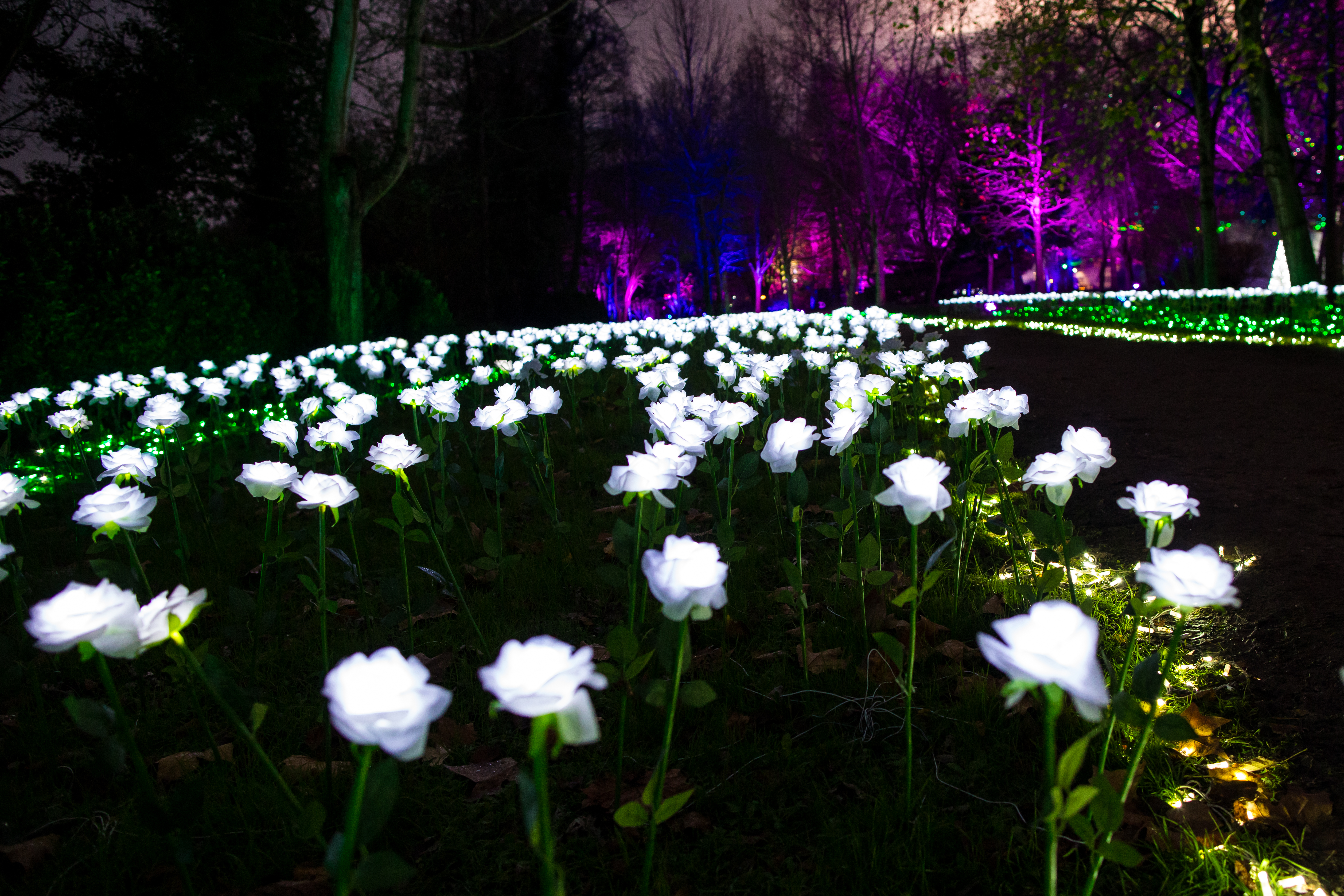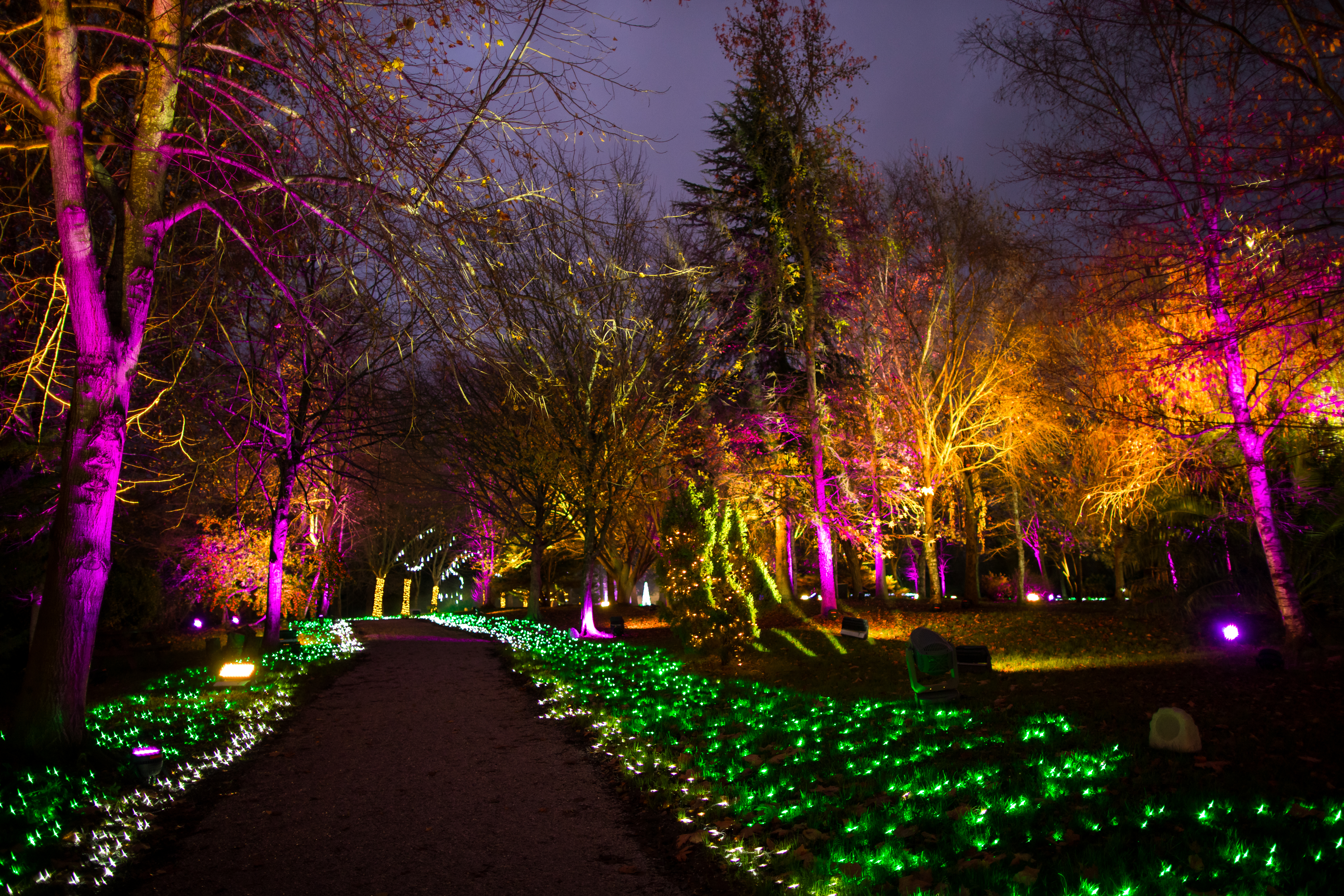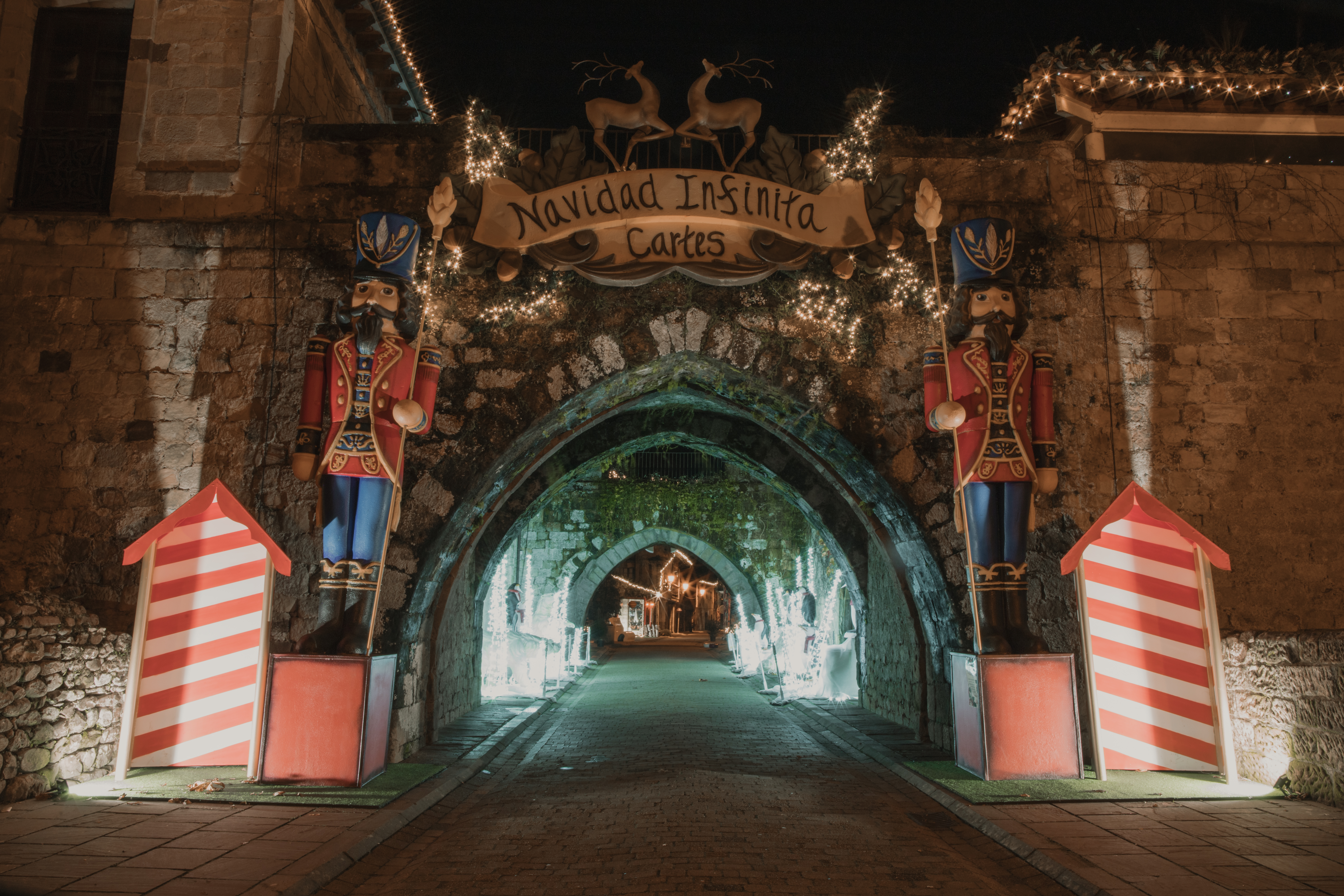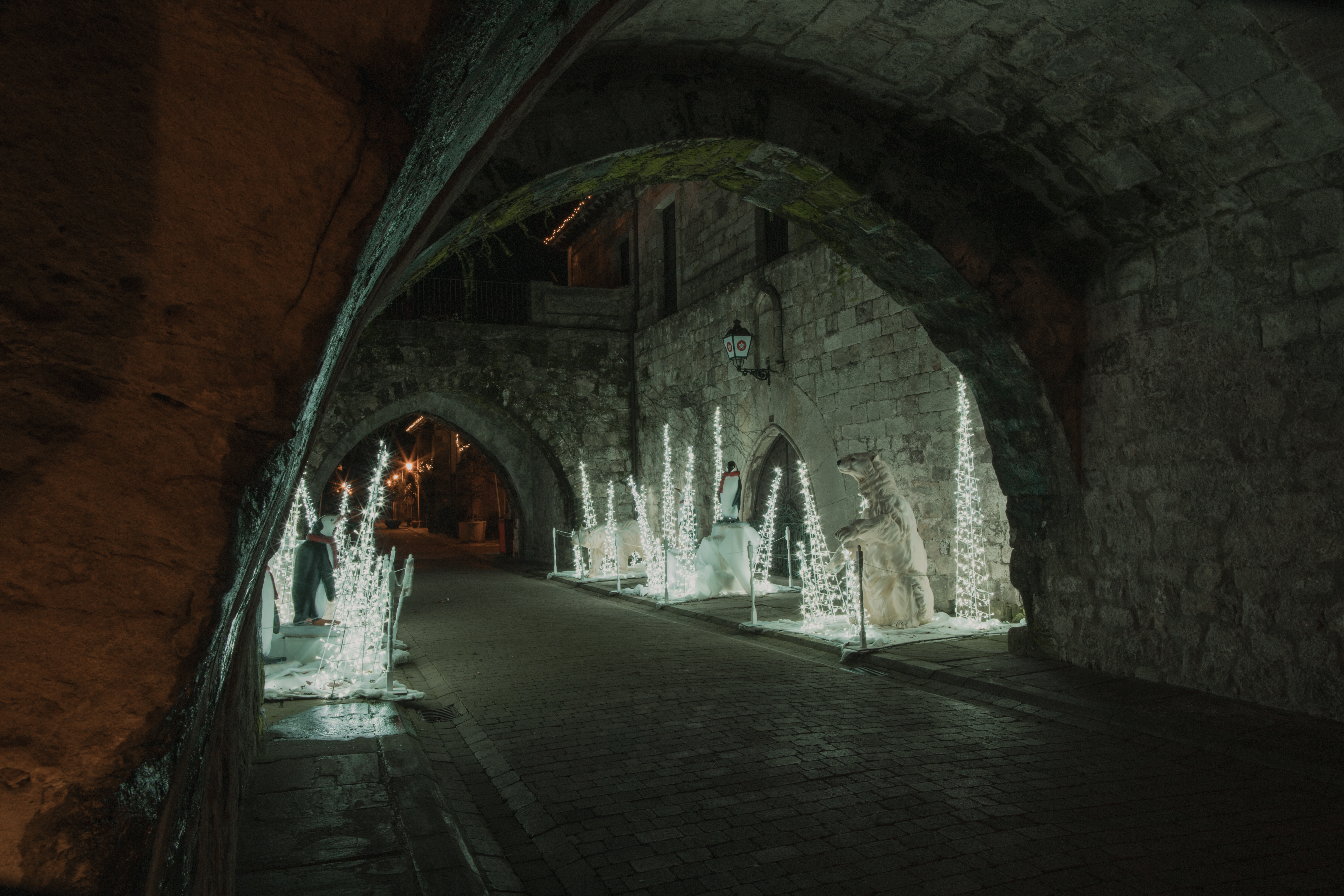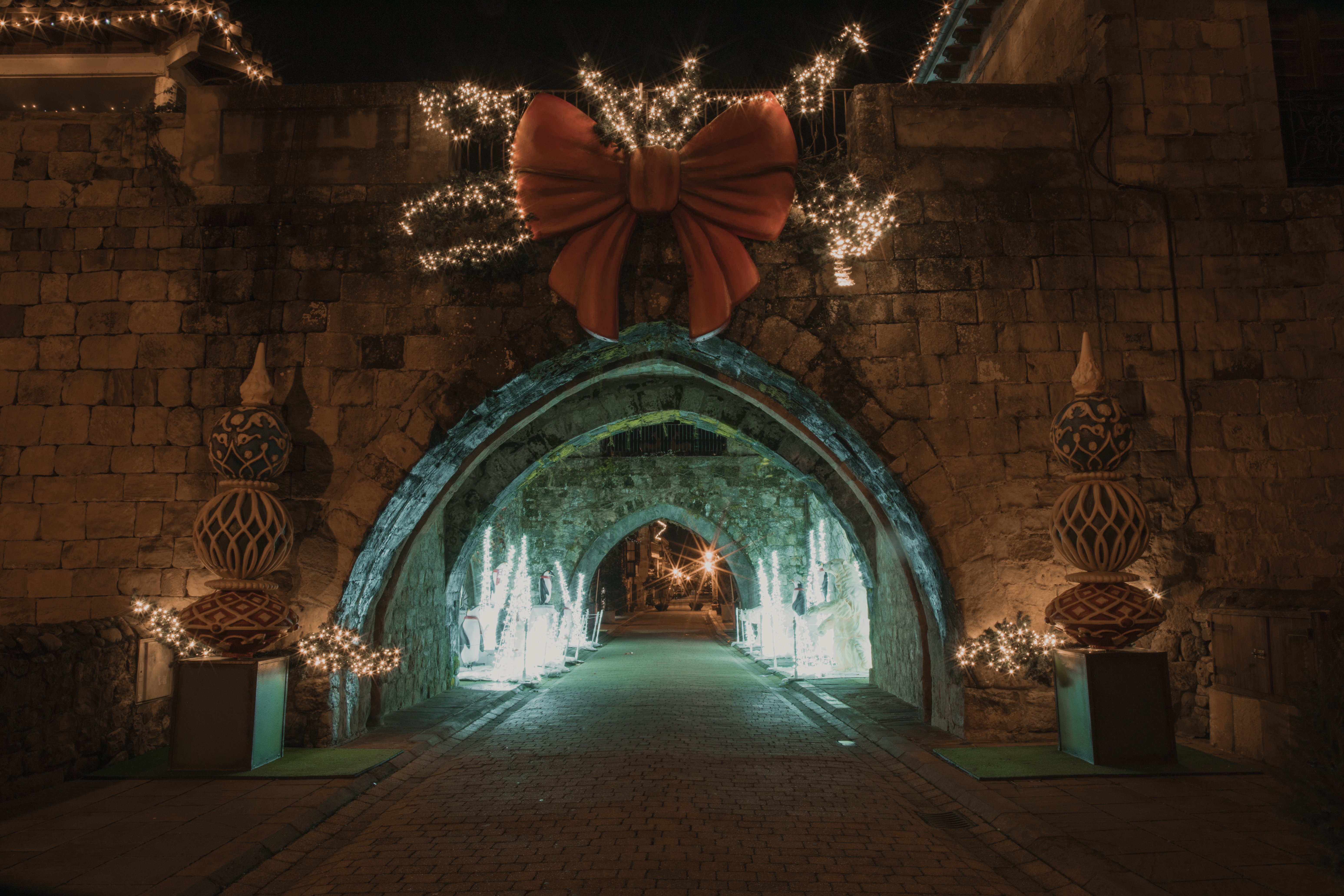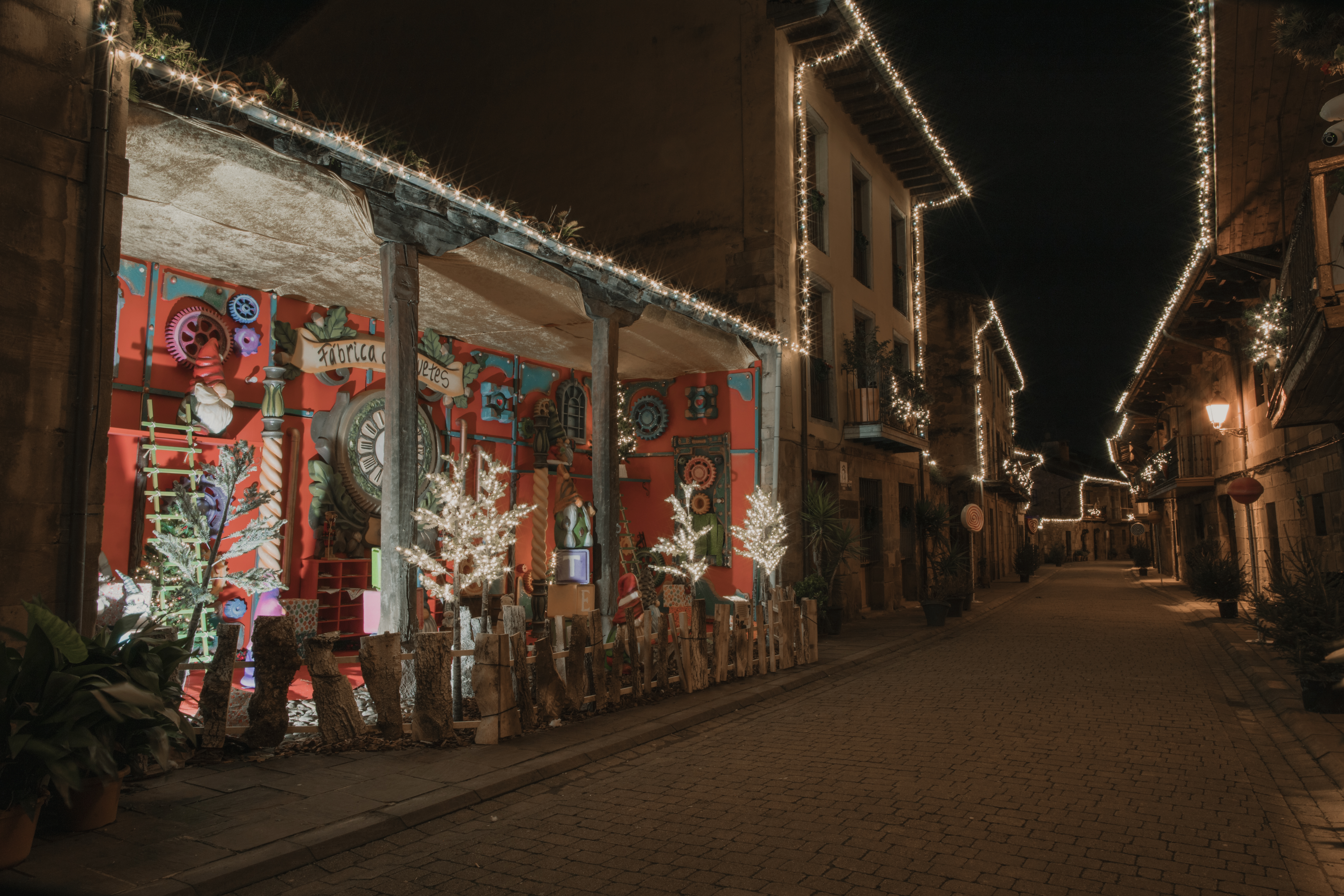Regaining a sense of belonging
Iluminating our future
lluminating Heritage: Experiencing European Christmas through Historical and Natural Spaces
The revitalization and preservation of old heritage by bringing symbolic lights and festive engagement. With the spirit of enhancing a sense of European identity awareness, the aim is to develop a permanent natural space (specially on Christmas), an immersive environment, that highlights the diversity of European traditions and values. Considering our rural framework, the kids play a key role for community learning and strengthening cultural exchange of European identity.
Spain
Local
Cartes
Mainly rural
It refers to other types of transformations (soft investment)
Yes
2025-01-06
Yes
EDIC (European Direct Information Center of Cantabria Region)
No
No
As a representative of an organisation
The project "Illuminating Our Future" aims to enhance the historical and cultural heritage of Cartes, with a particular focus on the Camino Real and Parque del Ánsar. By integrating festive lighting and European Christmas symbolism, the initiative strengthens local identity while fostering European values and solidarity.
Since 2023, the Town Council has been committed to promoting the municipality’s historical and natural heritage during the Christmas season. This initiative has engaged thousands of visitors and played a key role in the internationalization of the community. By focusing on young people, especially children (final beneficiaries), the project strengthens the connection between future generations and European traditions, reinforcing a shared cultural identity.
Through the use of architectural and natural spaces, the project serves as a model for heritage-based economic and cultural development. By celebrating Christmas as a common European tradition, it contributes to local economic growth while positioning Cartes as a seasonal destination that highlights its historical significance.
The Camino Real has already incorporated contributions from private actors, including local businesses, associations, and regional public institutions.
The project seeks to establish a permanent European dimension, aligning with the values outlined in Article 3 of the Treaty on European Union, which promote cohesion, cultural diversity, and sustainable development.
A key innovation was the annual selection of an original Christmas theme, chosen through participatory processes involving local youth (aged 6 to 25) and community stakeholders, including trade organizations, the local development agency, and the hospitality sector.
This participatory approach strengthenes civic engagement, ensuring that young people play an active role in shaping their cultural environment while fostering European integration through shared traditions.
Since 2023, the Town Council has been committed to promoting the municipality’s historical and natural heritage during the Christmas season. This initiative has engaged thousands of visitors and played a key role in the internationalization of the community. By focusing on young people, especially children (final beneficiaries), the project strengthens the connection between future generations and European traditions, reinforcing a shared cultural identity.
Through the use of architectural and natural spaces, the project serves as a model for heritage-based economic and cultural development. By celebrating Christmas as a common European tradition, it contributes to local economic growth while positioning Cartes as a seasonal destination that highlights its historical significance.
The Camino Real has already incorporated contributions from private actors, including local businesses, associations, and regional public institutions.
The project seeks to establish a permanent European dimension, aligning with the values outlined in Article 3 of the Treaty on European Union, which promote cohesion, cultural diversity, and sustainable development.
A key innovation was the annual selection of an original Christmas theme, chosen through participatory processes involving local youth (aged 6 to 25) and community stakeholders, including trade organizations, the local development agency, and the hospitality sector.
This participatory approach strengthenes civic engagement, ensuring that young people play an active role in shaping their cultural environment while fostering European integration through shared traditions.
Leisure
Heritage
Childhood
Christmas
Lights
he planned route for this initiative extends approximately 500 meters through the Historic-Artistic Site of Cartes (designated in 1985). Surrounded by historic mansions, noble coats of arms, and traditional flowered balconies, the project carefully respects and integrates the local architectural heritage while leading visitors towards Parque del Ánsar.
The lighting and decorations along the route are designed to harmoniously blend natural elements—such as the river, trees, and native wildlife—with historical and recreational themes selected by the local population. This approach fosters community involvement and reinforces a collective sense of identity and belonging, particularly in a municipality situated near a larger urban center. The guiding philosophy, “to bring the light of the local population,” ensures that the project serves as both a cultural revival and a tool for strengthening local pride.
At the heart of the route, Parque del Ánsar acts as the central space where lighting installations highlight the natural surroundings while incorporating artistic recreations of European mythologies and historical narratives. This fusion of nature and culture promotes a deeper appreciation of European heritage and shared traditions.
By attracting visitors while maintaining a strong link to the town’s history and community identity, the project aims to establish Cartes as a unique seasonal destination, where tradition, sustainability, and European values come together in a meaningful and immersive experience.
The lighting and decorations along the route are designed to harmoniously blend natural elements—such as the river, trees, and native wildlife—with historical and recreational themes selected by the local population. This approach fosters community involvement and reinforces a collective sense of identity and belonging, particularly in a municipality situated near a larger urban center. The guiding philosophy, “to bring the light of the local population,” ensures that the project serves as both a cultural revival and a tool for strengthening local pride.
At the heart of the route, Parque del Ánsar acts as the central space where lighting installations highlight the natural surroundings while incorporating artistic recreations of European mythologies and historical narratives. This fusion of nature and culture promotes a deeper appreciation of European heritage and shared traditions.
By attracting visitors while maintaining a strong link to the town’s history and community identity, the project aims to establish Cartes as a unique seasonal destination, where tradition, sustainability, and European values come together in a meaningful and immersive experience.
This project integrates festive decoration with the architectural and natural heritage of Cartes, using historical representations of Christmas as a cultural bridge. Engaging local businesses and the hospitality sector, it fosters economic activity while respecting traditional aesthetics. Inspired by the New European Bauhaus, it merges sustainability, beauty, and community participation to create a meaningful and immersive experience that strengthens social cohesion.
A key element is the revival of the Magosta, an ancestral tradition recently restored as a central part of the community’s festive celebrations. In this event, local youth gather to roast chestnuts over an open fire while singing to the rhythm of traditional Cantabrian instruments such as the tambourine, pitu, and drum.
This initiative not only reinforces intergenerational ties but also preserves the region’s intangible cultural heritage, ensuring that younger generations remain connected to local traditions.
To deepen the relationship between the town’s historical roots and its European identity, the Camino Real has been transformed into a cultural route that showcases European-themed decorations in historically significant areas. A key highlight is the European Market, located in the Torreón de Cartes, a medieval structure that was once part of the Manrique de Lara Castle. This space serves as a meeting point for cultural exchange and commerce, linking local traditions with broader European influences.
Additionally, the route extends to the San Cipriano Mountain, incorporating historical narratives and strengthening the connection between the built environment and natural landscapes.
At the heart of the project lies Parque del Ánsar, where a carefully designed lighting installation symbolizes the balance between nature and cultural heritage. This luminous space reflects the coexistence of past and present, reinforcing a collective sense of identity among both residents and visitors.
A key element is the revival of the Magosta, an ancestral tradition recently restored as a central part of the community’s festive celebrations. In this event, local youth gather to roast chestnuts over an open fire while singing to the rhythm of traditional Cantabrian instruments such as the tambourine, pitu, and drum.
This initiative not only reinforces intergenerational ties but also preserves the region’s intangible cultural heritage, ensuring that younger generations remain connected to local traditions.
To deepen the relationship between the town’s historical roots and its European identity, the Camino Real has been transformed into a cultural route that showcases European-themed decorations in historically significant areas. A key highlight is the European Market, located in the Torreón de Cartes, a medieval structure that was once part of the Manrique de Lara Castle. This space serves as a meeting point for cultural exchange and commerce, linking local traditions with broader European influences.
Additionally, the route extends to the San Cipriano Mountain, incorporating historical narratives and strengthening the connection between the built environment and natural landscapes.
At the heart of the project lies Parque del Ánsar, where a carefully designed lighting installation symbolizes the balance between nature and cultural heritage. This luminous space reflects the coexistence of past and present, reinforcing a collective sense of identity among both residents and visitors.
The project was designed to be fully inclusive, allowing all residents and visitors—regardless of mobility, age, or socioeconomic background—to participate. Public spaces, including the Camino Real and Parque del Ánsar, were adapted to accommodate people with disabilities by incorporating clear pathways, rest areas, and guided routes. Additionally, all activities, such as the European Christmas Market, cultural performances, and interactive experiences, were free of charge, making them accessible to all social groups.
A crucial aspect of the project was its inclusive community participation and governance. Built on a participatory model, it involved diverse community groups in decision-making processes. Local youth played a key role in designing decorations and activities, fostering a sense of ownership and engagement. Senior citizen associations, such as Los Torreones, contributed their historical knowledge, ensuring intergenerational knowledge transfer and strengthening community cohesion. This collaborative approach allowed the project to reflect the needs and aspirations of all stakeholders.
The initiative also adhered to design for all principles, ensuring that the event layout was intuitive and welcoming to individuals with different needs, including families with young children and elderly visitors. Sustainable materials were prioritized in the decorations, aligning with the New European Bauhaus vision of creating inclusive, sustainable, and aesthetically pleasing spaces.
Beyond physical accessibility, the project introduced new societal models by strengthening local identity and promoting economic inclusion. By integrating historical heritage with cultural engagement, it reinforced Cartes as a vibrant and economically sustainable municipality.
The initiative also provided a platform for local businesses and artisans to showcase their work, ensuring that the economic benefits were distributed equitably within the community.
A crucial aspect of the project was its inclusive community participation and governance. Built on a participatory model, it involved diverse community groups in decision-making processes. Local youth played a key role in designing decorations and activities, fostering a sense of ownership and engagement. Senior citizen associations, such as Los Torreones, contributed their historical knowledge, ensuring intergenerational knowledge transfer and strengthening community cohesion. This collaborative approach allowed the project to reflect the needs and aspirations of all stakeholders.
The initiative also adhered to design for all principles, ensuring that the event layout was intuitive and welcoming to individuals with different needs, including families with young children and elderly visitors. Sustainable materials were prioritized in the decorations, aligning with the New European Bauhaus vision of creating inclusive, sustainable, and aesthetically pleasing spaces.
Beyond physical accessibility, the project introduced new societal models by strengthening local identity and promoting economic inclusion. By integrating historical heritage with cultural engagement, it reinforced Cartes as a vibrant and economically sustainable municipality.
The initiative also provided a platform for local businesses and artisans to showcase their work, ensuring that the economic benefits were distributed equitably within the community.
This project was designed with citizens at its core, ensuring active participation in every stage of development. To achieve this, a public-private partnership framework was established, involving regional authorities, local entrepreneurs, and community associations, such as the Riocorvo Cultural Association, which is composed of young residents committed to preserving and promoting local heritage.
The central element of the initiative—the festive lighting—was carefully curated to emphasize the role of traditions in shaping societal values. Inspired by the participatory philosophy of the Night of Candles, an event that transforms the architectural ensemble of Riocorvo with thousands of candle-lit displays, the project sought to engage citizens in defining their own cultural experience. Through a consultative process, the local population was encouraged to share their interests and perspectives, shaping the project’s activities to align with community needs and enhancing visitors' understanding of the municipality’s historical and natural heritage.
To foster engagement, an interactive guided tour was developed, allowing visitors to experience the illuminated route while participating in various activities designed for all families, with a special focus on children. By integrating storytelling, education, and artistic expression into the lighting displays, the project creates an immersive environment where history, tradition, and community spirit come together.
By prioritizing citizen involvement and fostering meaningful connections between people and place, the initiative strengthens social cohesion, promotes intergenerational learning, and aligns with the New European Bauhaus vision of creating inclusive, beautiful, and sustainable cultural spaces.
The central element of the initiative—the festive lighting—was carefully curated to emphasize the role of traditions in shaping societal values. Inspired by the participatory philosophy of the Night of Candles, an event that transforms the architectural ensemble of Riocorvo with thousands of candle-lit displays, the project sought to engage citizens in defining their own cultural experience. Through a consultative process, the local population was encouraged to share their interests and perspectives, shaping the project’s activities to align with community needs and enhancing visitors' understanding of the municipality’s historical and natural heritage.
To foster engagement, an interactive guided tour was developed, allowing visitors to experience the illuminated route while participating in various activities designed for all families, with a special focus on children. By integrating storytelling, education, and artistic expression into the lighting displays, the project creates an immersive environment where history, tradition, and community spirit come together.
By prioritizing citizen involvement and fostering meaningful connections between people and place, the initiative strengthens social cohesion, promotes intergenerational learning, and aligns with the New European Bauhaus vision of creating inclusive, beautiful, and sustainable cultural spaces.
The project’s development actively involved local businesses, particularly small retailers, alongside regional authorities, including the Government of Cantabria through the Directorate-General for European Funds. This collaborative approach ensured that the initiative reflected both local needs and broader European values.
By incorporating a European perspective and highlighting the historical significance of Christmas, young people participated in designing the decorations, tailoring the experience to the main target audience: families. This participatory process helped strengthen social cohesion, fostering meaningful interactions between residents and visitors.
As a result, more than 100,000 people immersed themselves in the project’s atmosphere, experiencing the organized route and activities. This influx of visitors generated a significant economic impact for a municipality of nearly 6,000 inhabitants, demonstrating how cultural heritage and community-driven initiatives can contribute to local development and cultural exchange.
By incorporating a European perspective and highlighting the historical significance of Christmas, young people participated in designing the decorations, tailoring the experience to the main target audience: families. This participatory process helped strengthen social cohesion, fostering meaningful interactions between residents and visitors.
As a result, more than 100,000 people immersed themselves in the project’s atmosphere, experiencing the organized route and activities. This influx of visitors generated a significant economic impact for a municipality of nearly 6,000 inhabitants, demonstrating how cultural heritage and community-driven initiatives can contribute to local development and cultural exchange.
Through featuring more than 24 activities across different areas of the Camino Real, incorporating artistic, cultural, and intergenerational elements. Artistic performances included dance exhibitions by local schools and traditional Christmas carol processions, while cultural events such as the Magosta and the collective ascent to Monte de San Cipriano reinforced local traditions. Additionally, intergenerational initiatives, such as competitions and meetings with senior residents, fostered social cohesion and knowledge exchange between generations.
By aligning these diverse activities with the significance of the Christmas season, the project successfully engaged key areas of the municipality, strengthening community participation and enhancing the cultural and economic vibrancy of Cartes.
By aligning these diverse activities with the significance of the Christmas season, the project successfully engaged key areas of the municipality, strengthening community participation and enhancing the cultural and economic vibrancy of Cartes.
A key strength of the project was the seamless coexistence of historical architecture with the municipality’s natural landscape. At its heart lies the Camino Real (Royal Way), an ancient and highly protected route dating back to the mid-18th century, originally designed to connect Santander with Reinosa. This historic pathway is lined with grand manor houses, distinguished by their sunlit terraces and traditional balconies, preserving the town’s architectural heritage.
Cartes, of Celtic origin, carries a name that reflects its deep connection to the natural environment, blending the meanings of rock and watercourse. This etymology is rooted in the presence of the Carabete Stream, which emerges from the rock, shaping the town’s landscape and identity.
In alignment with this heritage, the project was designed to integrate lighting elements that symbolically represent the essence of Cartes—illuminating the rock along the promenade and highlighting the natural beauty of Parque del Ánsar. This fusion of light, history, and landscape creates an immersive experience that reinforces the town’s identity while respecting its cultural and environmental legacy.
Cartes, of Celtic origin, carries a name that reflects its deep connection to the natural environment, blending the meanings of rock and watercourse. This etymology is rooted in the presence of the Carabete Stream, which emerges from the rock, shaping the town’s landscape and identity.
In alignment with this heritage, the project was designed to integrate lighting elements that symbolically represent the essence of Cartes—illuminating the rock along the promenade and highlighting the natural beauty of Parque del Ánsar. This fusion of light, history, and landscape creates an immersive experience that reinforces the town’s identity while respecting its cultural and environmental legacy.
The Camino Real served as the central axis of the project, showcasing its cultural beauty while respecting its architectural integrity and emphasizing its historical significance within the Bajo Besaya region. As a heritage promenade, its direct economic impact is limited to specific service establishments.
To enhance its role as a cultural and experiential space, lighting was strategically used as a guiding element, creating an immersive nighttime journey. Along this illuminated path, key European-themed areas were integrated, including the European Christmas Market and the European Nature Forest, transforming the Camino Real into a space where history, tradition, and European identity converge.
To enhance its role as a cultural and experiential space, lighting was strategically used as a guiding element, creating an immersive nighttime journey. Along this illuminated path, key European-themed areas were integrated, including the European Christmas Market and the European Nature Forest, transforming the Camino Real into a space where history, tradition, and European identity converge.
First, the project introduced an innovative model that merges history with evolving traditions. In our region, festive celebrations have often been dominated by large urban centers. However, through collective preparation, we successfully revitalized our own traditions, using light as a central element to highlight both the historical and architectural value of the municipality.
Second, the project’s strength lay in the complementarity of its collaborating entities. It brought together diverse associations, ranging from senior groups such as the Asociación Cultural de Mayores de Los Torreones to youth organizations like the Valle de Cohicillos and Riocorvo Associations. Additionally, cultural and musical groups, including the Folklore Ensemble and El Corrucu Association, played a key role in enriching the initiative.
Third, the structured approach—introducing a guided and organized route—enhanced accessibility for families, creating an engaging and immersive experience. This model not only strengthened community participation but also fostered local economic growth by connecting historical heritage with local artistic and cultural initiatives.
Second, the project’s strength lay in the complementarity of its collaborating entities. It brought together diverse associations, ranging from senior groups such as the Asociación Cultural de Mayores de Los Torreones to youth organizations like the Valle de Cohicillos and Riocorvo Associations. Additionally, cultural and musical groups, including the Folklore Ensemble and El Corrucu Association, played a key role in enriching the initiative.
Third, the structured approach—introducing a guided and organized route—enhanced accessibility for families, creating an engaging and immersive experience. This model not only strengthened community participation but also fostered local economic growth by connecting historical heritage with local artistic and cultural initiatives.
Addressing aging demographics while fostering youth participation in local economic development was a key priority of the project.
Young people, in particular, have been the main beneficiaries—both through publicly driven employment opportunities and by actively involving them in initiatives that promote and showcase the municipality. By encouraging their engagement, the project strengthens intergenerational ties and ensures that the town’s cultural and economic vitality continues into the future.
A central objective was to reconnect young people with their historical heritage. The Camino Real, today primarily a transit route between different areas of the municipality, holds significant historical value. To highlight its importance, the project focused on enhancing the visibility of its architectural landmarks and the stories embedded within them.
Through guided activities, interactive experiences, and educational initiatives, the project transformed the Camino Real from a simple passageway into a living testament to the municipality’s rich past. This approach not only deepened local identity but also reinforced the role of cultural heritage as a driver of sustainable economic growth and community cohesion.
Young people, in particular, have been the main beneficiaries—both through publicly driven employment opportunities and by actively involving them in initiatives that promote and showcase the municipality. By encouraging their engagement, the project strengthens intergenerational ties and ensures that the town’s cultural and economic vitality continues into the future.
A central objective was to reconnect young people with their historical heritage. The Camino Real, today primarily a transit route between different areas of the municipality, holds significant historical value. To highlight its importance, the project focused on enhancing the visibility of its architectural landmarks and the stories embedded within them.
Through guided activities, interactive experiences, and educational initiatives, the project transformed the Camino Real from a simple passageway into a living testament to the municipality’s rich past. This approach not only deepened local identity but also reinforced the role of cultural heritage as a driver of sustainable economic growth and community cohesion.
The project has had a significant impact on the local community, delivering concrete results in cultural revitalization, economic growth, and social inclusion. By transforming the Camino Real into a space of historical celebration, the initiative reinforced local identity while promoting European values of solidarity, sustainability, and coexistence.
A key outcome was the increase in community participation. More than 100,000 visitors engaged with the project, bringing renewed attention to the town’s heritage. The initiative strengthened intergenerational ties by involving senior associations in preserving traditions and young people in co-creating decorations and activities. This exchange fostered a stronger sense of belonging and community pride.
The economic impact was also significant. Local businesses, particularly small retailers, hospitality establishments, and artisans, benefited from increased visitor numbers. The European Christmas Market provided a platform for local entrepreneurs, boosting the economy during the holiday season. Additionally, the project created temporary job opportunities, especially for young people involved in event organization and guided tours.
From a social inclusion perspective, the project ensured accessibility for all. Free cultural activities and participatory governance allowed people from diverse economic backgrounds and physical abilities to engage. By integrating European traditions and values, the initiative fostered intercultural dialogue, strengthening the connection between the local community and the broader European identity.
Beyond the local level, the project positioned Cartes as a model of heritage-led innovation in Europe, demonstrating how small municipalities can successfully integrate historical preservation with modern cultural engagement to revitalize public spaces.
A key outcome was the increase in community participation. More than 100,000 visitors engaged with the project, bringing renewed attention to the town’s heritage. The initiative strengthened intergenerational ties by involving senior associations in preserving traditions and young people in co-creating decorations and activities. This exchange fostered a stronger sense of belonging and community pride.
The economic impact was also significant. Local businesses, particularly small retailers, hospitality establishments, and artisans, benefited from increased visitor numbers. The European Christmas Market provided a platform for local entrepreneurs, boosting the economy during the holiday season. Additionally, the project created temporary job opportunities, especially for young people involved in event organization and guided tours.
From a social inclusion perspective, the project ensured accessibility for all. Free cultural activities and participatory governance allowed people from diverse economic backgrounds and physical abilities to engage. By integrating European traditions and values, the initiative fostered intercultural dialogue, strengthening the connection between the local community and the broader European identity.
Beyond the local level, the project positioned Cartes as a model of heritage-led innovation in Europe, demonstrating how small municipalities can successfully integrate historical preservation with modern cultural engagement to revitalize public spaces.

